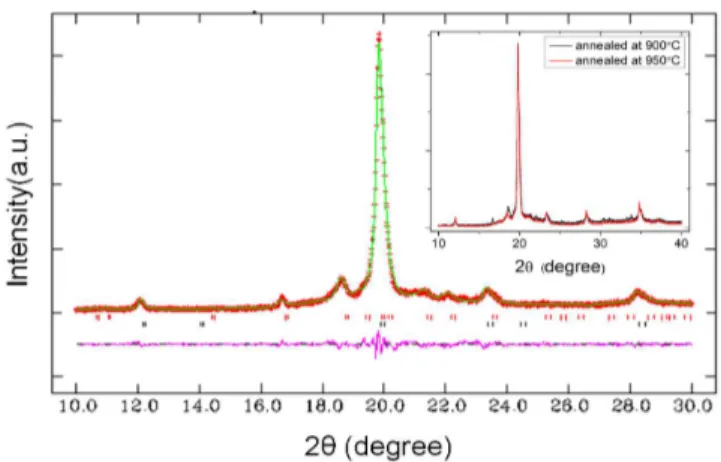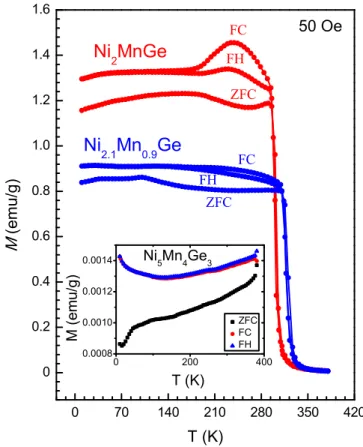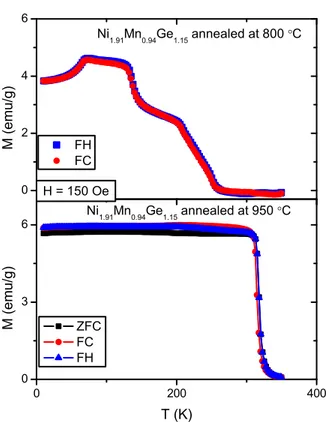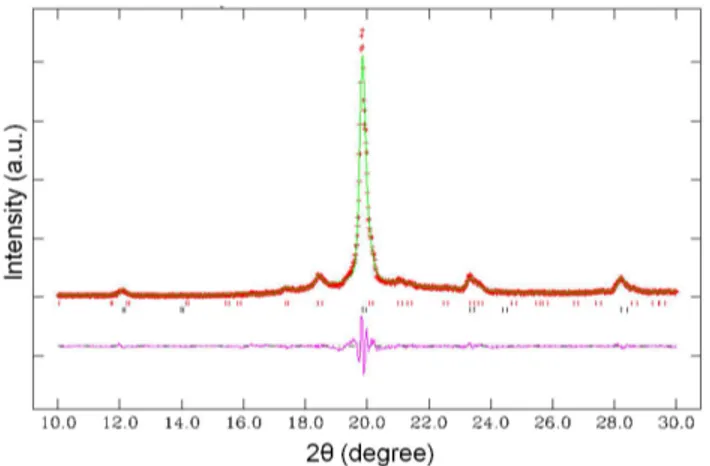arXiv:1408.4241v1 [cond-mat.mtrl-sci] 19 Aug 2014
alloy
U. Adem,1 ˙I. Din¸cer,1 S. Akt¨urk,2 M. Acet,3 and Y. Elerman1
1
Department of Engineering Physics, Faculty of Engineering, Ankara University, 06100 Besevler, Ankara, Turkey
2
Department of Physics, Faculty of Sciences and Letters,
Mu˘gla University, 48000 K¨otekli, Mu˘gla, Turkey
3
Experimental Physics, Duisburg-Essen University, 47048 Duisburg, German (Dated: August 20, 2014)
We have systemically studied the effects of annealing temperature and alloy composition on the
structural and magnetic properties of bulk Ni2MnGe and Ni2
.1Mn0.9Ge Heusler alloys. We have
observed that both annealing temperature and the alloy composition drastically alter the phases
found in the samples due to the presence of competing ternary phases. Annealing at 900 and 950◦C
for both alloy compositions facilitate the formation of L21 Heusler phase. Nevertheless, formation
of Ni5Mn4Ge3 and Ni16Mn6Ge7 phases cannot be prevented for Ni2MnGe and Ni2
.1Mn0.9Ge alloys,
respectively. In order to estimate the magnetic contribution of the Ni5Mn4Ge3 impurity phase to
that of the parent Ni2MnGe, we have also synthesized pure Ni5Mn4Ge3 alloy. Antiferromagnetic
nature of Ni5Mn4Ge3 with low magnetization response allows us to reveal the magnetic response of
the stoichiometric bulk Ni2MnGe. Bulk Ni2MnGe shows simple ferromagnetic behavior with a Curie
temperature of 300 K, in agreement with the previous results on thin films. Despite the divergence of magnetization curves between field cooled (FC) and field heated (FH) modes, stoichiometric
Ni2MnGe alloy does not undergo a martensitic phase transition based on our variable temperature
x-ray diffraction experiments.
PACS numbers:
Ni-Mn based Heusler alloys constitute a prime fam-ily of compounds that have been studied extensively due to the presence of a magnetostructural phase tran-sition which makes them useful for magnetic refriger-ation and magnetic shape memory applicrefriger-ations such as actuators1–3. Upon cooling, Ni-Mn-Z (where Z =
Ga,In,Sn,Sb) undergo a phase transition into a marten-sitic phase. Only for Ni2MnGa phase, martensitic phase
transition occurs for the stoichiometric Heusler compo-sition in the ferromagnetic state. Associated with the first order martensitic phase transition, (magnetic) shape memory effects are observed in these alloys. Magnetic and structural phase transition temperatures can be tai-lored to yield large caloric effects, which makes them use-ful for magnetic refrigeration applications1.
Despite the abundance of studies on other Heusler compositions, there have been relatively few studies on Ni2MnGe both in bulk and thin film form. Lund et al.
have reported the growth of thin films of Ni2MnGe using
Molecular Beam Epitaxy (MBE) and obtained ferromag-netic films with a Curie temperature of 300 K4. Kim et
al. have grown Ni2MnGe films using flash evaporation.
Their films were ferromagnetic with a Curie tempera-ture of 280 K5. Only Oksenenko et al. have reported
the structural and magnetic properties of stoichiometric bulk Heusler composition Ni2MnGe6. They could not
obtain a pure Heusler phase and observed complex mag-netization behaviour accordingly. Si et al. synthesized bulk Ni2.1Mn0.9Ge and Ni2.2Mn0.8Ge7. They claimed
to obtain pure off-stoichiometric Heusler phase. Their magnetic measurements show a simple ferromagnetic
be-havior with an ordering temperature TC of 246 K for
Ni2.1Mn0.9Ge and 151 K for Ni2.2Mn0.8Ge.
The key property that renders other Ni-Mn based Heusler alloys useful for applications is the presence of a first-order martensitic phase transition from high temper-ature L21phase to a low temperature martensite phase1.
Zayak et al. predicted an instability of L21 structure
in Ni2MnGe alloys using first-principles calculations but
this has not been observed so far8. Recently, there has
been another prediction9, suggesting the likelihood of a
transition from the cubic austenite phase to a tetrago-nal martensite phase. We have undertaken a system-atic study to clarify the structural and magnetic prop-erties of stoichiometric bulk Ni2MnGe and to address
the martensitic phase transition predictions. In addi-tion to the stoichiometric composiaddi-tion, we have also syn-thesized Ni2.1Mn0.9Ge alloy, in order to reproduce the
pure L21 Heusler phase claimed in ref.7. Another
off-stoichiometric sample with the determined composition of Ni1.91Mn0.94Ge1.15was also used to study the effect of
Ni off-stoichiometry and demonstrate the effect of anneal-ing temperature. We have observed that annealanneal-ing tem-perature and alloy composition significantly affect the phases encountered in the alloys. Finally, we show the lack of a martensitic phase transition using variable tem-perature x-ray diffraction experiments.
I. EXPERIMENTAL
Ni2MnGe, Ni2.1Mn0.9Ge, Ni5Mn4Ge3 and
Ni1.91Mn0.94Ge1.15 alloys were synthesized by
arc-melting the constituting elements under Ar atmosphere using an Arc Melter. The alloys were melted 5 times to assure melt homogeneity. Ni2MnGe and Ni2.1Mn0.9Ge
alloys were annealed first at 900◦C for 3 days in order
to reproduce the synthesis conditions in ref.7 and then
subsequently annealed at 950 ◦C for 4 days to see the
effects of higher temperature on the stability of phases. Ni5Mn4Ge3 alloy was annealed at 800◦C for 6 days
following ref.10. Ni
1.91Mn0.94Ge1.15 was annealed at
800◦C for a week and then subsequently annealed at
950◦C for another week. Annealing was done with
samples closed in quartz tubes under Ar atmosphere and alloys were quenched in ice water. Composition of the alloys were checked using Energy Dispersive X-ray Spectroscopy(EDS) with a Zeiss EVO 40 Scanning Electron Microscope (SEM). Crystal structure of the alloys were determined using x-ray diffraction experi-ments with a Rigaku D-Max 2200 diffractometer with Mo K-alpha radiation at room temperature. Variable temperature x-ray diffraction experiments were carried out using a Rigaku Smartlab diffractometer having a Cu K-alpha source equipped with a commercial temperature attachment, between 83-573 K. Le Bail fits to the x-ray diffraction data were done using GSAS software package11. Magnetization of the samples were measured
in a MPMS magnetometer between 10-380 K.
II. RESULTS AND DISCUSSION
Fig. 1 shows the Le Bail fit of the x-ray diffraction data of the stoichiometric Ni2MnGe alloy annealed at 900◦C
for 3 days collected at room temperature. All peaks can be indexed with Heusler L21phase with the space group
Fm¯3m and Ni5Mn4Ge3 impurity phase. Ni5Mn4Ge3
is reported to crystallize in hexagonal P63/mmc space
group10. Lattice parameters from the Le Bail fit were
obtained as a = 5.8224(4)˚A for the cubic Ni2MnGe
phase and a = 4.9288(9)˚A and c = 7.680(3)˚A for the Ni5Mn4Ge3 phase, respectively. Upon further annealing
at 950 ◦C for 4 days, Ni5Mn4Ge3 peaks lose their
in-tensity (shown in the inset of Fig. 1), however a pure Ni2MnGe phase cannot be obtained.
In Fig. 2(a), Backscattered Electron (BSD)image of Ni2MnGe alloy is shown. There are thin dark regions
within the lightly colored matrix. Point analysis from dark regions show a stoichiometry close to Ni5Mn4Ge3
in agreement with the XRD data. Neighbouring lightly colored regions show stoichiometric Ni2MnGe
composi-tion (Table 1).
Le Bail fit of the x-ray diffraction data of Ni2.1Mn0.9Ge
annealed at 900 ◦C shown in Fig. 3 can be indexed
us-ing a mixture of L21 Ni2MnGe Heusler phase together
with Mn6Ni16Ge7. Mn6Ni16Ge7 phase is cubic with the
FIG. 1: X-ray diffraction pattern of Ni2MnGe sample
an-nealed at 900◦C for 3 days. Black ticks denote L2
1 Heusler
peaks whereas red ticks show Ni5Mn4Ge3 impurity phase.
Observed data is red, calculated is in green and the difference is in pink. The inset shows a comparision of the diffraction
patterns corresponding to the sample annealead at 900 ◦C
and subsequently at 950◦C.
Composition Ni Mn Ge
Ni2MnGe (dark regions) 45.83 (41.7) 31.45 (33.3) 22.72 (25)
Ni2MnGe (light regions) 49.83 (50) 25.42 (25) 24.75 (25)
Ni2
.1Mn0.9Ge 51.91 (52.5) 22.81 (22.5) 25.27 (25)
Ni1
.91Mn0.94Ge1.15 47.8 (47.8) 23.5 (23.5) 28.7 (28.7)
TABLE I: Elemental analysis results of Ni2MnGe(dark
regions), Ni2MnGe(light regions), Ni2
.1Mn0.9Ge and
Ni1
.91Mn0.94Ge1.15. The numbers in parenthesis denote the
expected values for the respective phases: i.e. Ni5Mn4Ge3
stoichiometry for Ni2MnGe (dark regions), Ni2MnGe
sto-ichiometry for Ni2MnGe (light regions) and Ni2
.1Mn0.9Ge
stoichiometry for Ni2
.1Mn0.9Ge.
space group Fm¯3m10. Refined lattice parameters were
a = 5.7881(5)˚A and a = 11.4164(6)˚A for Ni2MnGe and Mn6Ni16Ge7, respectively. Further annealing at 950◦C
doesn’t change the stability of the phases.
In Fig. 2(b), BSD image of Ni2.1Mn0.9Ge alloy is
shown. Unlike the case in Ni2MnGe composition, no dark
and lightly colored regions could be observed, therefore the presence of a second phase with Mn6Ni16Ge7
stoi-chiometry couldn’t be verified. On the other hand, ele-mental analysis from a large area showed that the target composition has been obtained (Table 1).
In Fig. 4, we show the temperature depen-dence of magnetization of Ni2MnGe, Ni2.1Mn0.9Ge and
Ni5Mn4Ge3 samples measured at 50 Oe. Sharp increase
in magnetization in both FC and FH modes define the ferromagnetic Curie temperature as 300 K for Ni2MnGe
and 320 K for Ni2.1Mn0.9Ge. There is divergence
be-tween FC and FH modes, hinting the possibility of the presence of a first order martensitic phase transition. In order to quantify the contribution of Ni5Mn4Ge3
im-(a)
(b)
FIG. 2: Backscattered Electron (BSD) SEM images of
(a)Ni2MnGe alloy, annealed at 900 ◦C for 3 days. Figure
shows a zoomed-in region where dark colored Ni5Mn4Ge3
phase can be seen, surrounded by the lighter colored regions
of Ni2MnGe phase, (b) Ni2
.1Mn0.9Ge alloy, annealed at 900
◦C for 3 days.
FIG. 3: Le Bail fit of the x-ray diffraction pattern of
Ni2
.1Mn0.9Ge sample annealed at 900
◦C for 3 days. Black
ticks denote L21 Heusler peaks whereas red ticks show
Ni16Mn6Ge7 impurity phase. 0 70 140 210 280 350 420 0 0.2 0.4 0.6 0.8 1.0 1.2 1.4 1.6 0 200 400 0.0008 0.0010 0.0012 0.0014 ZFC FC FH M ( e m u / g ) T (K) Ni 5 Mn 4 Ge 3 Ni 2.1 Mn 0.9 Ge ZFC FH FC ZFC FH M ( e m u / g ) T (K) 50 Oe FC Ni 2 MnGe
FIG. 4: Temperature dependence of magnetization of
Ni2MnGe, Ni2
.1Mn0.9Ge and Ni5Mn4Ge3measured at 50 Oe.
purity to the magnetic behaviour of Ni2MnGe, a
pris-tine Ni5Mn4Ge3 alloy was synthesized. Le Bail fit of
XRD data of Ni5Mn4Ge3 alloy is shown in Fig. 5.
Refined lattice parameters are a = 4.8865(3)˚A and c = 7.6662(7)˚A. Temperature dependence of magnetiza-tion of pure Ni5Mn4Ge3 is shown in the inset of Fig.
4. Ni5Mn4Ge3 shows complex magnetic response,
dom-inantly antiferromagnetic, however since the magnitude of magnetization is very small, magnetic contribution of Ni5Mn4Ge3to the behavior of parent Ni2MnGe is
negli-gible.
Our studies show that Ni2.1Mn0.9Ge alloy contains two
phases: L21 Ni2MnGe Huesler phase and Mn6Ni16Ge7
(Fig. 3). Si et al. however claim that they observe only L21Heusler phase7. Magnetic properties of Mn6Ni16Ge7
are unknown but provided that it shows dominantly an-tiferromagnetic properties similar to Ni5Mn4Ge3, simple
ferromagnetic behaviour that Si et al. have reported, assigned to L21Heusler phase, can be understood.
Observation of three ternary phases (Ni2MnGe,
Mn6Ni16Si7 and Ni5Mn4Ge3) in a narrow composition
range might seem unusual when one considers the num-ber of ternary phases in Ni-Mn-Ga(only one)12 however
formation of quite a few ternary phases are known for both Ni-Mn-Ge10 and Ni-Mn-Si systems13. Ni-Mn-Si
ternary phase diagram hosts many ternary phases, in-cluding Mn6Ni16Si713,14. In the following, we will show
FIG. 5: Le Bail fit of x-ray diffraction pattern for Ni5Mn4Ge3
sample. All peaks correspond to Ni5Mn4Ge3.
that annealing temperature plays a crucial role for the formation of Heusler phase. We have observed a very similar magnetic behavior to that in Oksenenko et al., in a Mn and Ni deficient composition, Ni1.91Mn0.94Ge1.15,
when the sample was annealed at 800◦C, not at 900
or 950 ◦C. Temperature dependence of magnetization
of this alloy is shown in Fig. 6(a). There are mul-tiple anomalies, which probably correspond to differ-ent magnetic ordering phenomena. The differdiffer-ent and complex magnetic behavior that we observed can be ascribed to the different phases present in this alloy. Different to the Ni2MnGe and Ni2.1Mn0.9Ge
composi-tions, Ni1.91Mn0.94Ge1.15annealed at 800◦C doesn’t
con-tain L21 Heusler phase but includes Mn6Ni16Ge7 and
Ni5Mn4Ge3 phases. In Fig. 7, Le Bail fit of the X-ray
diffraction pattern of Ni1.91Mn0.94Ge1.15annealed at 800 ◦C is shown. Black tickmarks denote peaks belonging to
Ni5Mn4Ge3 phase, with the refined lattice parameters a
= 4.8944(3)˚A and c = 7.683(2)˚A, while red tickmarks correspond to Mn6Ni16Ge7phase, with the refined cubic
lattice parameter a = 11.526(1)˚A. More experiments are necessary to understand the magnetic anomalies in this alloy.
Annealing Ni1.91Mn0.94Ge1.15 composition further at
950◦C yields a mixture of L2
1 Heusler Ni2MnGe phase
with Mn6Ni16Ge7 present as the second phase (Fig. 7).
Refined lattice parameters were a = 5.8115(2)˚A for the Ni2MnGe phase and a = 11.475(2)˚A for Mn6Ni16Ge7.
Temperature dependence of magnetization of this alloy annealed at 950◦C is given in Fig. 6(b). Due to dominant
presence of cubic Heusler phase, magnetization shows fer-romagnetic ordering around 315 K, similar to the stoi-chiometric Ni2MnGe alloy as well as to off-stoichiometric
Ni2.1Mn0.9Ge, both containing cubic Heusler phases, as
shown in the Fig. 4.
Another major outcome of our study is the observa-tion of absence of a martensitic phase transiobserva-tion. As it has been discussed in the introduction section, there are theoretical calculations claiming the presence a structural instability in stoichiometric Ni2MnGe that can result in a
0 2 4 6 0 200 400 0 3 6 Ni 1.91 Mn 0.94 Ge 1.15 annealed at 800 C FH FC M ( e m u / g ) H = 150 Oe ZFC FC FH M ( e m u / g ) T (K) Ni 1.91 Mn 0.94 Ge 1.15 annealed at 950 C
FIG. 6: Temperature dependence of magnetization of
Ni1
.91Mn0.94Ge1.15 sample (a) annealed at 800
◦C, (b)
an-nealed at 950◦C, both measured at 150 Oe.
FIG. 7: Le Bail fit of the x-ray diffraction data for
Ni1.91Mn0.94Ge1.15 annealed at 800
◦C. Black tickmarks
de-note Ni5Mn4Ge3 peaks, while red tickmarks correspond to
Mn6Ni16Ge7 phase.
martensitic phase transition8,9. We are able to assess this
prediction satisfactorily by identifying the phases present in our samples. We have used Ni1.91Mn0.94Ge1.15
sam-ple annealed at 950◦C for this purpose. Refined
diffrac-tion pattern collected at RT was shown in Fig. 8. X-ray diffraction spectra of Ni1.91Mn0.94Ge1.15sample,
FIG. 8: Le Bail fit of the x-ray diffraction data for
Ni1
.91Mn0.94Ge1.15subsequently annealed at 950
◦C after
an-nealing at 800◦C. Black tickmarks denote L2
1 Ni2MnGe
peaks, while red tickmarks correspond to Mn6Ni16Ge7phase.
Fig. 9. Throughout this temperature range, including the part where a divergence between FC and FH curves in magnetization was observed, both cubic Heusler peaks and peaks belonging to Mn6Ni16Ge7phase have been
ob-served, with no additional peaks appearing. Therefore, we conclude that no martensitic transiton takes place for the stoichiometric Ni2MnGe alloy. An additional
re-flection corresponding to (420) plane, belonging to the cubic Heusler phase is visible at all temperatures, differ-ent than the data collected at RT with Mo-source lab x-ray diffractometer. This might be due to the different data collection times. The lack of a structural marten-sitic phase transition is surprising. Typically, a diver-gence in magnetization between FC and FH modes of magnetization originates from a structural phase transi-tion. Lack of a structural phase transition in our case suggests a magnetic origin for the divergence between FC and FH modes. Neutron diffraction experiments are necessary to reveal the origin of the divergence between FC and FH modes. The lack of martensitic phase transi-tion is supporting the previous results on Ge substitutransi-tion in Ni2MnGa1−xGex15. For x = 0.4, it was reported that
martensitic transition temperature decreased from 200 K to 50 K compared to the Ni2MnGa, suggesting the
sup-pression effect of Ge on the martensitic phase transition.
III. CONCLUSIONS
In conclusion, we synthesized alloy compositions close to the stoichiometric Heusler Ni2MnGe and observed
that in a narrow composition range, there are two other thermodynamically stable phases in addition to the L21 Ni2MnGe structure: Ni5Mn4Ge3 and Mn6Ni16Ge7.
By estimating the contribution from these phases, we have measured the intrinsic magnetic response of bulk Ni2MnGe, addressing the inconsistency in previous
re-20 40 60 80 * * * * * * (200) 83 K RT 573 K I n t e n si t y ( a . u . ) 2 Cu K (degree) (220) (111) (400) (422) 423 K * * * * (311) (420) * *
FIG. 9: X-ray diffraction spectrum of Ni1
.91Mn0.94Ge1.15
sample annealed at 950◦C for 6 days, collected at 83 K, RT,
423 K and 573 K. Star symbols denote the reflections
be-longing to the Mn6Ni16Ge7 phase; the rest of the reflections
belong to the parent Ni2MnGe phase.
ports. This also allowed us to evaluate the presence of a martensitic phase transition. We conclude from our vari-able temperature x-ray diffraction measurements that no martensitic phase transition takes place at the stoichio-metric Heusler composition Ni2MnGe. Due to the
pres-ence of various thermodynamically stable phases in equi-librium, forcing a martensitic phase transition by moving to an off-stoichiometric composition would be unlikely.
Acknowledgments
U. A. acknowledges E. Duman for helpful discussions and the financial support of Turkish Scientific and Tech-nological Research Council (T ¨UB˙ITAK) via 2232 Pro-gramme.
1
A. Planes, L. Manosa, and M. Acet, Journal of Physics Condensed Matter 21, 233201 (2009).
2
J. Liu, T. Gottschall, K. P. Skokov, J. D. Moore, and O. Gutfleisch, Nature Materials 11, 620 (2012).
3
K. Ullakko, J. K. Huang, C. Kantner, R. C. O’Handley, and V. V. Kokorin, Applied Physics Letters 69, 1966 (1996).
4
M. S. Lund, J. W. Dong, J. Lu, X. Y. Dong, C. J. Palm-strom, and C. Leighton, Applied Physics Letters 80, 4798 (2002).
5
R. J. Kim, N. N. Lee, B. J. Kim, Y. P. Lee, Y. Kudryavtsev, and K. W. Kim, IEEE Transactions on Magnetics 41, 0018 (2005).
6
V. A. Oksenenko, L. N. Trofimova, Y. N. Petrov, Y. V. Kudryavtsev, J. Dubowik, and Y. P. Lee, Journal of Ap-plied Physics 99, 063902 (2006).
7
P. Z. Si, J. J. Liu, C. Q. Chen, Q. Wu, Z. W. Jiao, and H. L. Ge, Journal of Alloys and Compounds 462, 1 (2008).
8
A. T. Zayak, W. A. Adeagbo, P. Entel, and K. M. Rabe, Applied Physics Letters 88, 111903 (2006).
9
H. Luo, F. Meng, G. Liu, H. Liu, P. Jia, E. Liu, W. Wang, and G. Wu, Intermetallics 38, 139 (2013).
10
Y. V. Kuzma, M. Y. Teslyuk, and E. I. Gladyshevskii, Journal of Structural Chemistry 3, 143 (1962).
11
A. Larson and R. V. Dreele, Los Alamos National Labora-tory Report LAUR 86, 748 (2000).
12
K. Gupta, Journal of Phase Equilibria and
Dif-fusion 29, 101 (2008), ISSN 1547-7037, URL
http://dx.doi.org/10.1007/s11669-007-9017-x.
13
K. Gupta, Journal of Phase Equilibria and
Dif-fusion 27, 529 (2006), ISSN 1547-7037, URL
http://dx.doi.org/10.1007/BF02736466.
14
M. Kolenda, A. Szytula, J. Leciejewicz, and C. Maletka, Journal of Magnetism and Magnetic Materials 96, 121 (1991).
15
I. Go´scia´nska, J. Dubowik, Y. V. Kudryavtsev, and



